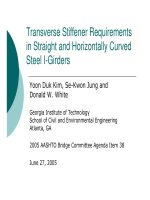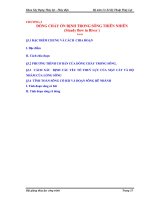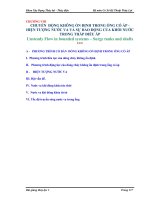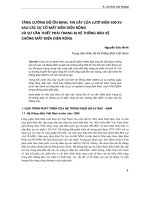Tăng cường độ ổn định trong dầm thép
Bạn đang xem bản rút gọn của tài liệu. Xem và tải ngay bản đầy đủ của tài liệu tại đây (422.67 KB, 33 trang )
Transverse Stiffener Requirements
in Straight and Horizontally Curved
Steel I-Girders
Yoon Duk Kim, Se-Kwon Jung and
Donald W. White
Georgia Institute of Technology
School of Civil and Environmental Engineering
Atlanta, GA
2005 AASHTO Bridge Committee Agenda Item 38
June 27, 2005
Problem Statement
Identify the demands on transverse
stiffeners in curved and straight
I-girders designed within the
AASHTO (2004) limits:
Transversely-stiffened I-girders with
d
o
/D < 3
D/t
w
< 150
Longitudinally-stiffened I-girders with
d
o
/D < 1.5
D/t
w
< 300
FEA Parametric Studies,
Test Configuration
Parametric Studies (Transversely-
Stiffened I-Girders)
D = 96 in (8 ft)
d
o
/D = 0.5, 1, 2 & 3
Straight & Curved with R = max(10d
o
, 100 ft)
D/t
w
= 150 (other D/t
w
values considered for flat webs)
F
yw
= F
ys
= 70 ksi (other F
y
values considered for flat webs)
F
yf
= 100 ksi (other F
y
values considered for flat webs)
b
f
/2t
f
= 6.47 (compact limit),
except b
f
/2t
f
= 5 for d
o
/D = 3
b
f
determined such that M
u
~ 0.75M
n
based on the
one-third rule
b
t
/t
p
= 10 in primary studies (other b
t
/t
p
considered in
supplementary studies)
Various one- and two-sided stiffener sizes
Parametric Studies (Longitudinally-
Stiffened I-Girders)
D = 96 in (8 ft)
d
o
/D = 0.5, 1 & 1.5
Straight & Curved with R = max(10d
o
, 100 ft)
D/t
w
= 300 (other D/t
w
values considered for flat webs)
F
yw
= F
ys
= 70 ksi (other F
y
values considered for flat webs)
F
yf
= 100 ksi (other F
y
values considered for flat webs)
b
f
/t
f
= 6.47 (compact limit)
b
f
determined such that M
u
~ 0.75M
n
based on the
one-third rule
b
t
/t
p
= 10 in primary studies (other b
t
/t
p
considered in
supplementary studies)
Various one- and two-sided stiffener sizes
Longitudinal stiffener not included in models
TFA Strength vs I
t
/I
tcr
d
o
/D = 1, D/t
w
= 150
I
tcr
= I
t
req’d to develop V
n
= V
cr
I
t
= nt
p
b
t
3
/3
I
t
= nb
t
4
/3/(b
t
/t
p
)
I
t
= A
s
2
(b
t
/t
p
)/3n
TFA Strength vs I
t
/I
tcr
d
o
/D = 1, D/t
w
= 150
AASHTO (2004)
area requirement,
two-sided stiffeners
AASHTO (2004)
area requirement,
one-sided stiffeners
Recommended
Shell Model - Perspective View of
Deformed Geometry at Max Load
I
t
= I
tcr
, d
o
/D = 1, D/t
w
= 150, 1-sided stiffener
Straight I-girder (note: 18.5I
tcr
is req’d to satisfy the AASHTO (2004) area reqmt)
Undeformed geometry
Deformed geometry
(Scale Factor = 5.0)
Shell Model – Mid-thickness Von Mises
Stress Distribution at Max Load
I
t
= I
tcr
, d
o
/D = 1, D/t
w
= 150, 1-sided stiffener
Straight I-girder (note: 18.5I
tcr
is req’d to satisfy the AASHTO (2004) area reqmt)
(Scale Factor = 5.0)
Perspective View of Deformed
Geometry at Max Load
I
t
= 6I
tcr
, d
o
/D = 1, D/t
w
= 150, 1-sided stiffener
Curved I-girder
(Scale Factor = 5.0)
Undeformed geometry
Deformed geometry
Mid-thickness Von Mises Stress
Distribution at Max Load
I
t
= 6I
tcr
, d
o
/D = 1, D/t
w
= 150, 1-sided stiffener
Curved I-girder
(Scale Factor = 5.0)
TFA Strength vs I
t
/I
tcr
d
o
/D = 1, D/t
w
= 300
Rahal and Harding (1990a)
“… the important panel influence on the stiffener
is lateral loading induced by panel buckling. For
panels bounded by actual flange members there is
evidence of a significant tension field loading on
the stiffener, but the effect of this, even for the
more slender plates considered, is less than the
beneficial effect resulting from the lateral stiffener
bending restraint provided by the flange. This
indicates that bending rigidity rather than axial
stiffness is the most important parameter for the
design of the stiffener, which supports the
emphasis placed on stiffener rigidity in the study
by Horne and Grayson.”









